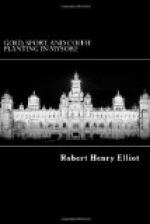Some planters, when pruning, remove moss and rub down the trees at the same time, but this, I am sure, can be done more cheaply and effectually as a separate work.
The removal of moss and rough bark, and generally cleaning and rubbing down the trees is a work of very great importance, and should be carried out once every two or three years. The injury arising from moss is too well known to call for any remark, but the reason why the removal of rough bark, and especially rough bark at the head of the tree, and at the junction of the topmost branches with the stem is of such importance is, that it is in the crevices of the rough bark that the Borer fly lays its eggs. When thus removing the moss and rough bark, the eggs may often be destroyed, and in the absence of rough bark to shelter them, it is probable that the insect would probably not lay the eggs at all, or that, if it did, they would either become addled, or fall to the ground. I may add here that we have found a piece of square tin the best thing for scraping down the trees, and that the hair-like fibre of the sago palm is an excellent thing for rubbing down the stems.
Though moss thrives best in damp situations, and on northern aspects, it sometimes exists on open and eastern aspects, and, when the latter is the case, the moss is certainly due to poverty of soil, and in such cases, in addition to scraping the trees thoroughly, an application of top soil mixed with lime, or bonedust, should be applied to the land. I may add that I have seen trees on a dry knoll, and with no shade over head, covered with moss, and this was no doubt owing to poverty of soil, which caused the bark to be in an unhealthy condition, and therefore a suitable home for the growth and spread of moss.
Digging and working the soil in order to keep it in an open condition is of great importance, because, to use for the second or third time the words of Sir John Lawes, “it is the physical condition of the soil, its permeability to roots, its capacity for absorbing and radiating heat, and for absorbing and retaining water, that is more important than its strictly speaking chemical condition.” In other words, a moderately fertile soil, if maintained in fine physical condition, will give better results than a rich one which is in a hardened state. But to keep the soil in good condition, and yet comply with the fruit cultivators’ chief axiom that, “from the time of blossom till the crop is ripe




